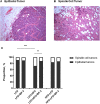Benzophenone-3 promotion of mammary tumorigenesis is diet-dependent
- PMID: 33400736
- PMCID: PMC7721615
- DOI: 10.18632/oncotarget.27831
Benzophenone-3 promotion of mammary tumorigenesis is diet-dependent
Abstract
Benzophenone-3 is a putative endocrine disrupting chemical and common ingredient in sunscreens. The potential of endocrine disrupting chemicals to act as agonists or antagonists in critical hormonally regulated processes, such as mammary gland development and mammary tumorigenesis, demands evaluation of its potential in promoting breast cancer. This study identifies the effects of BP-3 on mammary tumorigenesis with high-fat diet during puberty versus adulthood in Trp53-null transplant BALB/c mice. Benzophenone-3 exposure yielded levels in urine similar to humans subjected to heavy topical sunscreen exposure. Benzophenone-3 was protective for epithelial tumorigenesis in mice fed lifelong low-fat diet, while promotional for epithelial tumorigenesis in mice fed adult high-fat diet. Benzophenone-3 increased tumor cell proliferation, decreased tumor cell apoptosis, and increased tumor vascularity dependent on specific dietary regimen and tumor histopathology. Even in instances of an ostensibly protective effect, other parameters suggest greater risk. Although benzophenone-3 seemed protective on low-fat diet, spindle cell tumors arising in these mice showed increased proliferation and decreased apoptosis. This points to a need for further studies of benzophenone-3 in both animal models and humans as a potential breast cancer risk factor, as well as a more general need to evaluate endocrine disrupting chemicals in varying dietary contexts.
Keywords: benzophenone-3; breast cancer; dietary animal fat; mammary tumorigenesis; oxybenzone.
Copyright: © 2020 Kariagina et al.
Conflict of interest statement
CONFLICTS OF INTEREST Authors have no conflicts of interest to declare.
Figures








Similar articles
-
Benzophenone-3 alters expression of genes encoding vascularization and epithelial-mesenchymal transition functions during Trp53-null mammary tumorigenesis.Food Chem Toxicol. 2024 Apr;186:114540. doi: 10.1016/j.fct.2024.114540. Epub 2024 Feb 20. Food Chem Toxicol. 2024. PMID: 38387520 Free PMC article.
-
Adult withdrawal of long-term Benzophenone-3 treatment induces regression of mammary ductal branching in a diet-dependent manner.Food Chem Toxicol. 2025 Mar;197:115251. doi: 10.1016/j.fct.2025.115251. Epub 2025 Jan 16. Food Chem Toxicol. 2025. PMID: 39826681
-
Pubertal and adult windows of susceptibility to a high animal fat diet in Trp53-null mammary tumorigenesis.Oncotarget. 2016 Dec 13;7(50):83409-83423. doi: 10.18632/oncotarget.13112. Oncotarget. 2016. PMID: 27825136 Free PMC article.
-
Dietary fat, calories, and mammary gland tumorigenesis.Adv Exp Med Biol. 1992;322:203-22. doi: 10.1007/978-1-4684-7953-9_16. Adv Exp Med Biol. 1992. PMID: 1442296 Review.
-
Timing of dietary fat exposure and mammary tumorigenesis: role of estrogen receptor and protein kinase C activity.Mol Cell Biochem. 1998 Nov;188(1-2):5-12. Mol Cell Biochem. 1998. PMID: 9823005 Review.
Cited by
-
Benzophenone-3 alters expression of genes encoding vascularization and epithelial-mesenchymal transition functions during Trp53-null mammary tumorigenesis.Food Chem Toxicol. 2024 Apr;186:114540. doi: 10.1016/j.fct.2024.114540. Epub 2024 Feb 20. Food Chem Toxicol. 2024. PMID: 38387520 Free PMC article.
-
44-Year Retrospective Analysis of Ultraviolet Absorbents and Industrial Antioxidants in Seabird Eggs from the Canadian Arctic (1975 to 2019).Environ Sci Technol. 2022 Oct 18;56(20):14562-14573. doi: 10.1021/acs.est.2c05940. Epub 2022 Oct 5. Environ Sci Technol. 2022. PMID: 36198135 Free PMC article.
-
Biomonitoring of benzophenones in guano samples of wild bats in Poland.PLoS One. 2024 Apr 9;19(4):e0301727. doi: 10.1371/journal.pone.0301727. eCollection 2024. PLoS One. 2024. PMID: 38593171 Free PMC article.
-
Exposure to Low Doses of Oxybenzone During Perinatal Development Alters Mammary Gland Stroma in Female Mice.Front Toxicol. 2022 May 20;4:910230. doi: 10.3389/ftox.2022.910230. eCollection 2022. Front Toxicol. 2022. PMID: 35669359 Free PMC article.
-
Adult withdrawal of long-term Benzophenone-3 treatment induces regression of mammary ductal branching in a diet-dependent manner.Food Chem Toxicol. 2025 Mar;197:115251. doi: 10.1016/j.fct.2025.115251. Epub 2025 Jan 16. Food Chem Toxicol. 2025. PMID: 39826681
References
Grants and funding
LinkOut - more resources
Full Text Sources
Molecular Biology Databases
Research Materials

